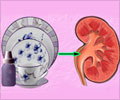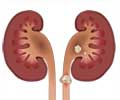Kidney stones partially dissolve and were found to regrow again as they form. Airyscan super-resolution microscopy was used to observe the interior growth history of the kidney stones.

‘Airyscan super-resolution microscopy was used by researchers to view the kidney stones at 140-nanometer resolution, where clear, colourful images of the interior growth history of the kidney stones was observed.’





This contradicts the widely held notion that kidney stones are homogenous rocks that never dissolve and are different from all other rocks in nature, said lead author Bruce Fouke, geology and microbiology professor at the University of Illinois. "Contrary to what doctors learn in their medical training, we found that kidney stones undergo a dynamic process of growing and dissolving.
"This means that one day we may be able to intervene to fully dissolve the stones right in the patient's kidney, something most doctors today would say is impossible," Fouke said.
The research, published in the journal Scientific Reports, demostrated that "instead of being worthless crystalline lumps, kidney stones are a minute-by-minute record of the health and functioning of a person's kidney".
"Before this study, it was thought that a kidney stone is just a simple crystal that gets bigger over time," said Jessica Saw, from the Mayo Clinic.
Advertisement
For the study, the team used a novel technology -- Airyscan super-resolution microscopy -- that allowed them to view the samples at 140-nanometer resolution --spectacularly clear, colourful images of the interior growth history of the kidney stones.
Advertisement
In the earliest stages of kidney stone development, crystals of a hydrated form of calcium oxalate adhere to one another, forming a big, irregular clump.
Layers of organic matter and crystals build up on top of this inner core, creating an outer shell. The stones continue to dissolve and grow.
But many of the layers were disrupted, revealing that part of the stones - usually the interior dihydrate crystals - had dissolved. New crystals of a dehydrated form of calcium oxalate had begun to grow again within those voids.
Scientists and doctors who study and treat kidney disease will now need to rethink their basic assumptions, the study noted.
Source-IANS















